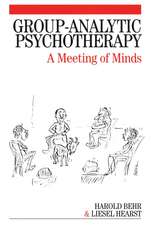Japanese Psychotherapies: Silence and Body-Mind Interconnectedness in Morita, Naikan and Dohsa-hou
Autor Velizara Chervenkovaen Limba Engleză Paperback – 7 iun 2019
| Toate formatele și edițiile | Preț | Express |
|---|---|---|
| Paperback (1) | 682.37 lei 39-44 zile | |
| Springer Nature Singapore – 7 iun 2019 | 682.37 lei 39-44 zile | |
| Hardback (1) | 897.33 lei 3-5 săpt. | |
| Springer Nature Singapore – 22 ian 2018 | 897.33 lei 3-5 săpt. |
Preț: 682.37 lei
Preț vechi: 897.87 lei
-24% Nou
Puncte Express: 1024
Preț estimativ în valută:
130.58€ • 134.91$ • 108.62£
130.58€ • 134.91$ • 108.62£
Carte tipărită la comandă
Livrare economică 17-22 martie
Preluare comenzi: 021 569.72.76
Specificații
ISBN-13: 9789811097973
ISBN-10: 9811097976
Pagini: 275
Ilustrații: XX, 275 p. 57 illus., 29 illus. in color.
Dimensiuni: 155 x 235 mm
Ediția:Softcover reprint of the original 1st ed. 2017
Editura: Springer Nature Singapore
Colecția Springer
Locul publicării:Singapore, Singapore
ISBN-10: 9811097976
Pagini: 275
Ilustrații: XX, 275 p. 57 illus., 29 illus. in color.
Dimensiuni: 155 x 235 mm
Ediția:Softcover reprint of the original 1st ed. 2017
Editura: Springer Nature Singapore
Colecția Springer
Locul publicării:Singapore, Singapore
Cuprins
Introduction.- Part I: Japan - A Land on the Edge of the World.- Chapter 1: Travelling in Silence – an attempt for cultural-anthropological reading of the Japanese kokoro.- Chapter 2: Silence Takes Shape – the birth of the Japanese psychotherapies.- Part II: The Sun Rising at the Gate.- Chapter 3: Morita Therapy – Chopping Wood, Carrying Water. Life Happens.- Chapter 4: Naikan Therapy – Memento mori.- Chapter 5: Dohsa-hou Therapy – Where Body Meets Soul.- Part III: Into the Depths: Silence Beneficial, Silence Torturing.- Chapter 6: The Will for Rising up – A Case Study at a Summer Dohsa-hou Camp.- Chapter 7: Tortured Bodies, Tortured Souls – Fieldwork Research on Written Naikan among Drug-Addicted Bulgarians.-
Chapter 8: “Then go and wash your rice bowl!” – Personal Experiences in Morita Therapy.- General Conclusion: Representative Japanese Psychotherapies in a Nutshell.- Appendix I - Morita Therapy.- Appendix II – Naikan Therapy.- Appendix III – Dohsa-hou Therapy.Notă biografică
Dr. Chervenkova’s research is focused on the original Japanese psychotherapeutic approaches – Morita, Naikan, and Dohsa-hou – and on their implementation among non-Japanese clients. As the English-language literature on the subject is yet relatively scarce, the author is committed to present these approaches outside of Japan (Asia) in a comprehensive work, making the most of her years-long research experience and training in Japan.
Textul de pe ultima copertă
The book presents three Japanese psychotherapeutic approaches, Morita, Naikan, and Dohsa-hou, in the chronological order of their development, giving a thorough account of both their underlying concepts and practical applications. In addition to describing their idiosyncrasies, a major focus of the book is also to elucidate as to how the deeply imprinted cultural specificities of these approaches, emanating from their common cultural ground, converge to two focal points—silence and body-mind interconnectedness—that vest the approaches with their therapeutic power. In so doing, the book gives an insight into the intrinsic dynamics of the methods and emphasizes on their potential for universal applicability notwithstanding their indisputable cultural peculiarities. This self-contained and well-structured book fills the gap in the yet scarce English-language literature on Japanese psychotherapies.
Caracteristici
Presents research that is both theoretical and empirical Uses general-to-particular approach to explain the culturally-bound essence of the therapies Refers to original Japanese sources for introducing less known facts and/or clarifying existing fallacies Includes supplementary material: sn.pub/extras


















